©Copyright 2018 GEOSCIENCE RESEARCH INSTITUTE
11060 Campus Street • Loma Linda, California 92350 • 909-558-4548

Beaches bring to our mind treasured memories, often associated with recreation and spiritual renewal. Beaches also represent places of significant economic value, central to many industries such as fishing, trading, real estate, and tourism. Additionally, beaches have played an iconic role in history, as explorers, conquerors, and armies expanded into other territories.
We may think of beaches as a static and permanent boundary between dry land and the sea, but naturalists know that beaches are highly dynamic environments of great geological and biological importance. For biologists, beaches represent a distinctive habitat to which numerous organisms are specifically adapted. For geologists, beaches represent a unique environment where processes of erosion, transport, and sedimentation can co-occur.
Beaches constantly change in size, shape, and even composition, sometimes on rapid timescales of a few weeks, days, or even hours during major storms. Beaches act as a buffer protecting nearshore land from erosion, by dissipating the energy of waves that would otherwise impact coastal terrains.
What are beaches made of?
Most beaches in the world, especially at mid-latitudes, are made up of terrigenous,[1] siliceous sand (Fig. 1).
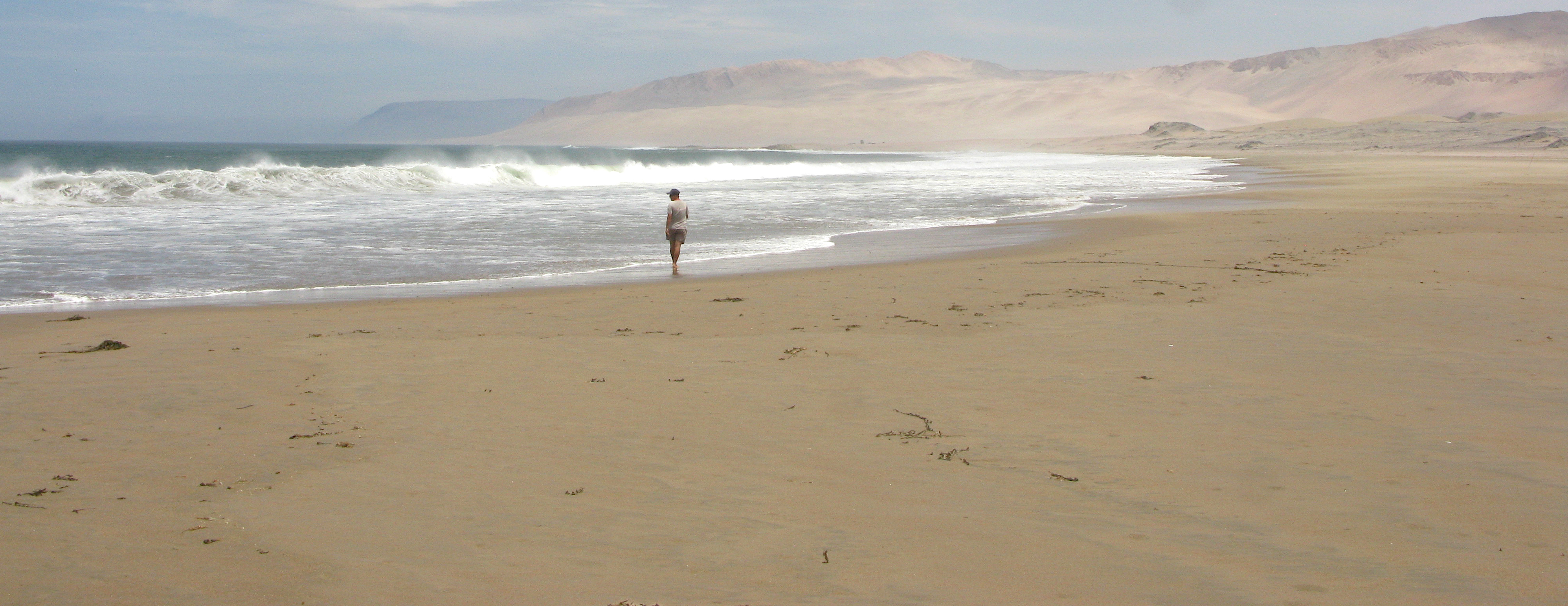
Figure 1. Punta Lomitas Beach, Peru. Sand in this beach consists mainly of siliceous grains, which may originate from erosion of the submerged bedrock, erosion of coastal outcrops, or sediment transported by rivers from the continent. Photo by Raúl Esperante.
In the tropics, however, beaches often consist of biogenic[2] sand mostly made up of shells and skeletal fragments of marine organisms (Fig. 2).

Figure 2. Sandy beach on the north shore of Santa Cruz Island, Galapagos. Note the contrast between the black basalt rock of the island and the light color of the sand. Examination of the sand with a lens shows that it is composed of fragments of shells and skeletons of marine organisms. The rocky coast is steadily eroded but the volcanic grains do not accumulate on the beach. The iron formations in the middle of the beach are the remains of a shipwreck, which are also being destroyed by the action of waves. Photo by Raúl Esperante.
In some beaches, shells can accumulate to form characteristic ridges called cheniers, separated by mud-flat deposits and swamps. Millions of disarticulated shells can be found in these cheniers, which may extend for tens of kilometers in length (Fig. 3).
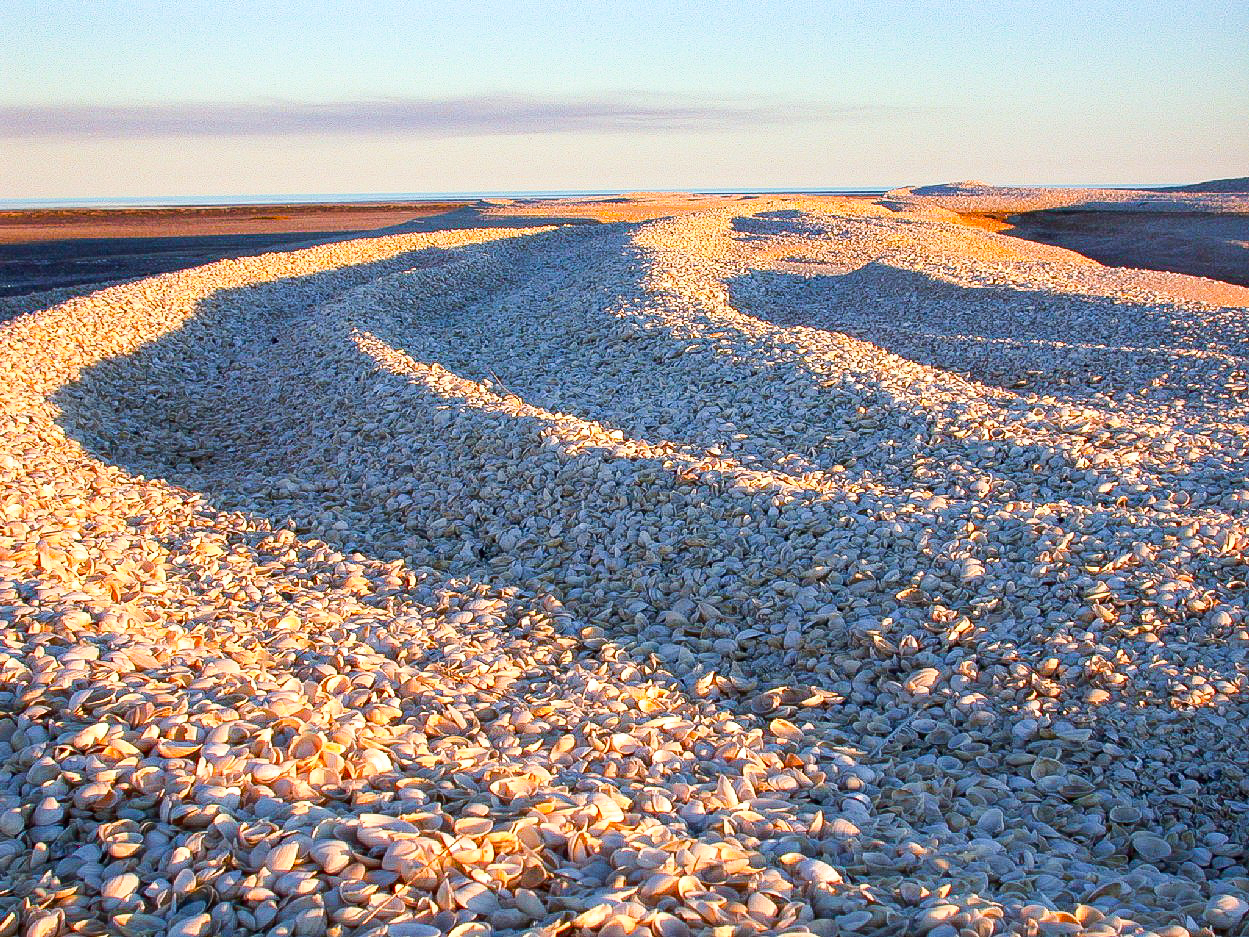
Figure 3. These two photos show cheniers on a mudflat in the Colorado River Delta area, North of San Felipe, Baja California Norte, Mexico. Shells in these cheniers accumulated along the shore forming several parallel ridges, several tens of meters wide, up to 2 m thick, and several kilometers long. The accumulation is monotypic, consisting mostly of shells of the same species, pushed onshore during storms. Photos by Raúl Esperante.
Other beaches are made up of grains of volcanic rocks, especially on volcanic islands, with sand typically forming from the erosion of volcanic ash or basaltic rock (Fig. 4). Beaches may be partially covered by rafted vegetation debris and tree logs transported by adjacent rivers and redeposited alongshore during storms (Fig. 4).
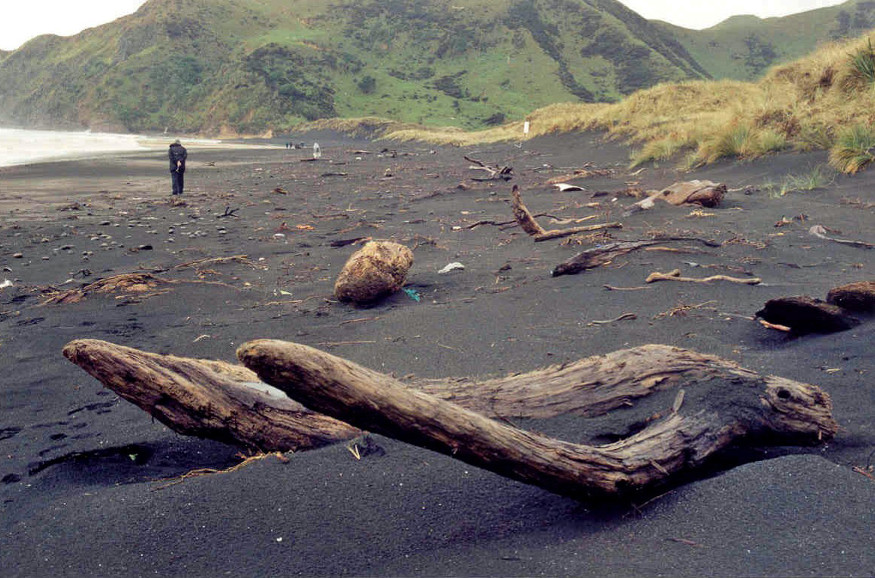
Figure 4. Sandy beach on the North Island of New Zealand. The shore is made of coarse volcanic sand derived from the erosion of the cliffs. Vegetation in the backshore helps stabilize the coastal dunes and prevents erosion by wind, although hide tides and storms can rapidly modify and destroy the dunes. Note the high amount of plant debris brought into the ocean by rivers and deposited on shore. Photo by Raúl Esperante.
Beside composition, grainsize is another important attribute of the sediment occurring on a beach. Most beaches are made up of fine to medium sand, but coarser-grained beaches are not uncommon, with the constituent particles ranging in size from pebbles (4-64 mm in diameter), cobbles (64-256 mm in diameter), and boulders, which are even larger rock fragments (Fig. 5).
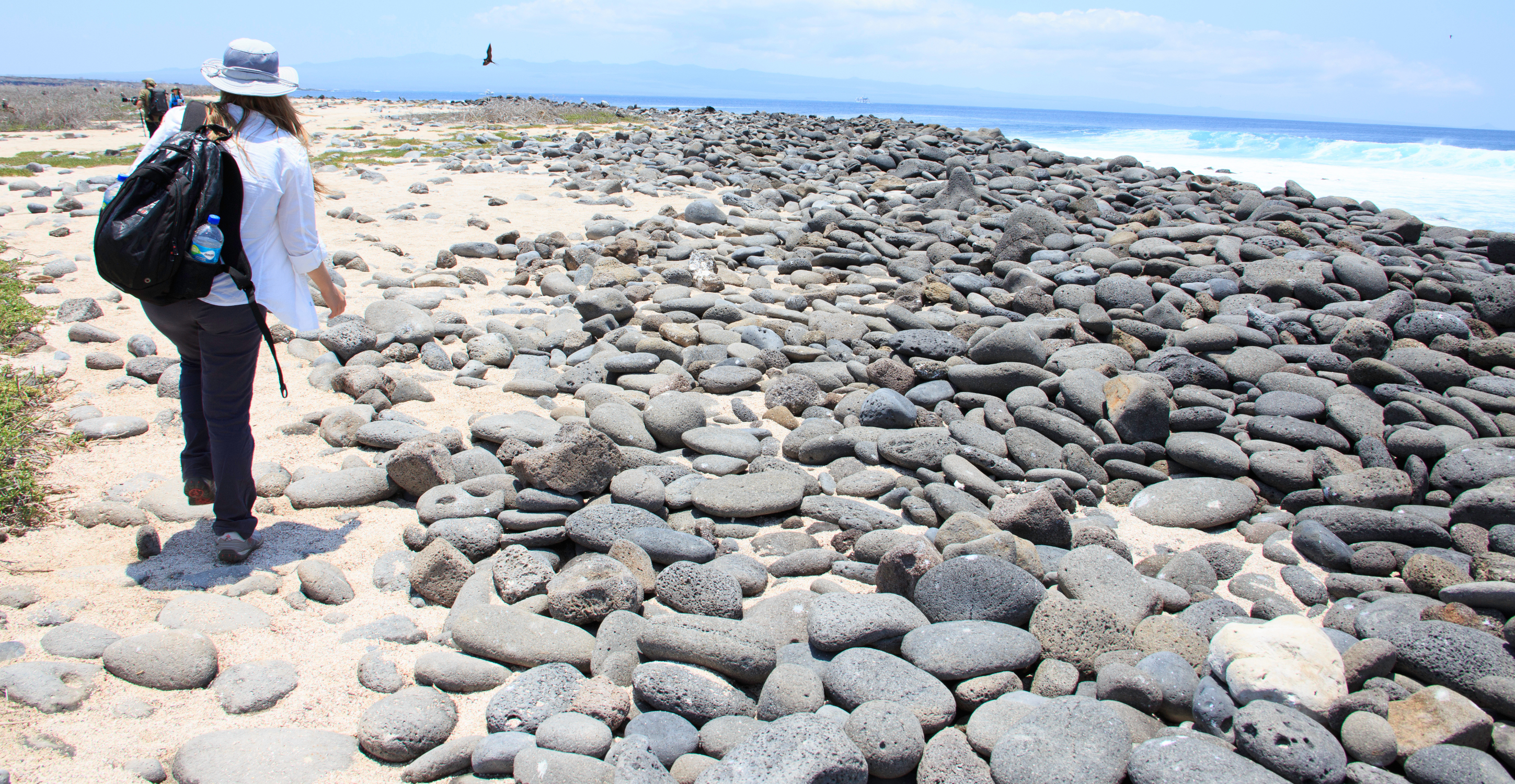
Figure 5. Beach boulders and cobbles on the eastern shore of North Seymour Island, Galapagos. The island is made up of black basalt rock, but the light-colored calcareous coarse sand consists of fragments of shells and other skeletons of marine organisms. Dark, well-rounded boulders and cobbles cover the sandy beach. These clasts result from fracturing and dislodgment of basalt blocks along shoreline outcrops and rounding of the blocks by the action of waves. Storms push the clasts upward onshore and arrange them in an imbricated pattern, as noticed by the partial overlapping of some elongated boulders. Photo by Raúl Esperante.
Beaches composed of large-sized grains often show examples of particle imbrication, i.e., flatter grains are leaning on each other in the same direction, with the lower edge of one grain partially resting on the upper surface of another grain (Fig. 6).
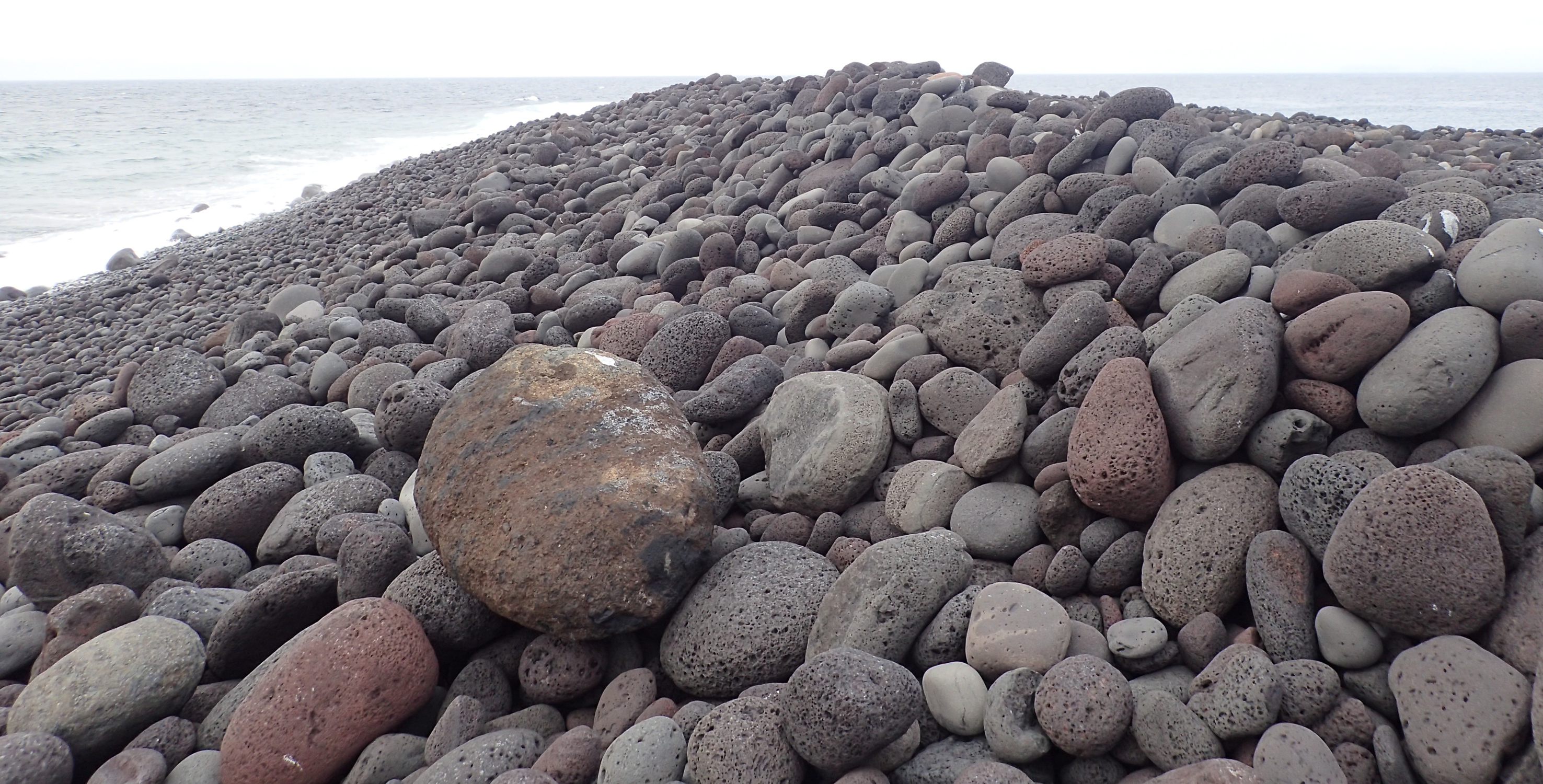
Figure 6. Rounded and semi-rounded boulders on the northern shore of Surtsey Island, about 40 km south of mainland Iceland. The boulders lay on the volcanic substrate and formed as a result of rapid breakup of solidified lava cliffs during the effusive phase in 1965. Notice partial imbrication of the clasts, which lie at a high angle of inclination resting on the upper surface of underlying clasts. Strong storms impact the rocky coast of Surtsey, eroding the solid volcanic cliffs, rounding up eroded fragments and accumulating them in the stable imbricated position. Photo by Raúl Esperante.
Imbrication is caused by the breaking and swashing of ocean waves over the beach, which pushes rock particles upward and landward, an effect that is accentuated during storms.
At the opposite side of the grainsize spectrum, we find some extensive coastal areas that lack real beaches but consist of mudflats and estuaries where fine-grained sediment is predominant (Fig. 7).
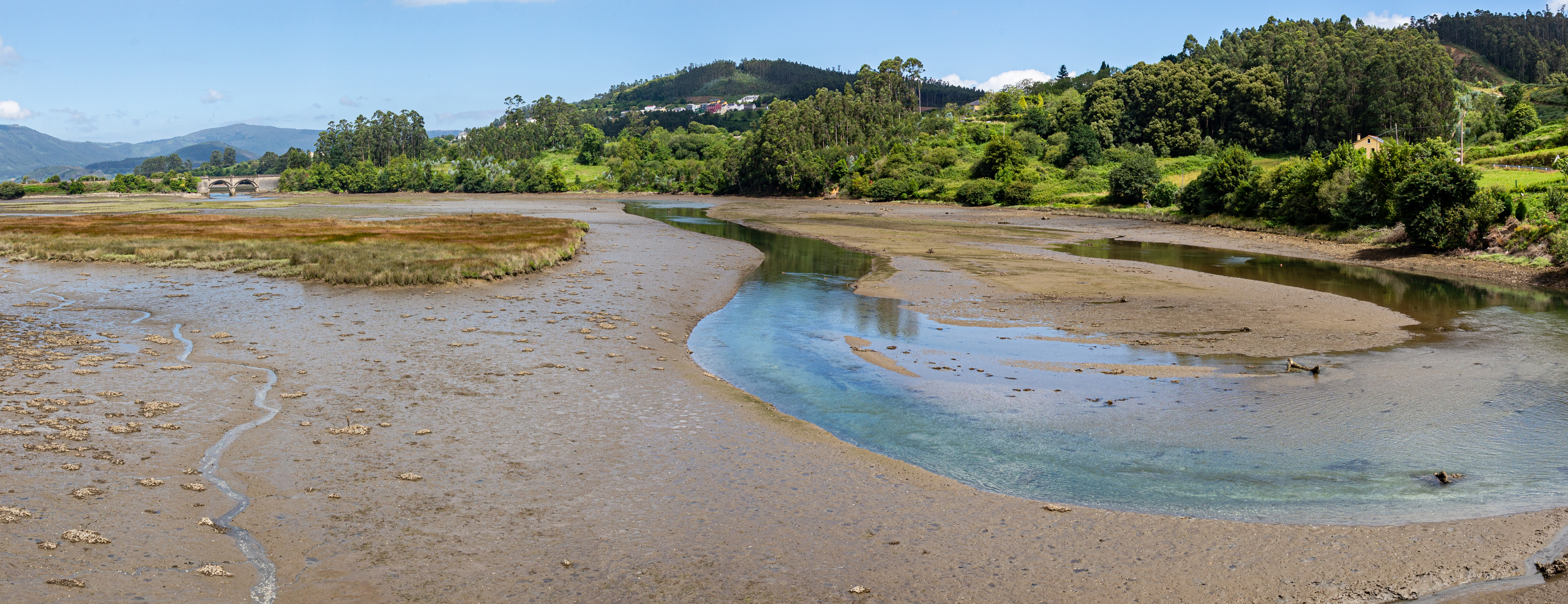
Figure 7. Mudflat at the mouth of the Mera River, Ría de Ortigueira, Lugo, Spain, where tides oscillate between a low 0.3 m and a maximum amplitude of 3.8 m on a mostly flat estuary that extends several kilometers inland. In many areas of the estuary, the accumulated mud has been stabilized by vegetation forming small islands. Photo by Raúl Esperante.
The source area from which the sediment that makes up a beach is derived is another important factor to understand beach dynamics. In some cases, the material can be derived from a relatively local source, such as an adjacent rocky coast, or a nearby river or glacier. Simple observation helps to quickly differentiate between a biogenic and terrigenous source. For example, beaches in the Galapagos Islands are mostly pale cream in color, whereas the islands consist mostly of black and dark brown volcanic rock (Figs. 2, 5). Examination of the particles that constitute those beaches show that they consist of light-colored calcareous sands made up of fragments of shells and reef organisms that live in the nearshore waters.
Some materials travel long distances, in the order of hundreds of kilometers, from the interior of continents before being deposited on a beach. Alongshore transport can also significantly displace sediment from a source point.
What factors control the dynamics of a beach?
The erosion, transport, and deposition of grains and particles on a beach is determined by a complex combination of factors, which include, to name a few, type of source rock, river discharge, size of transported particles, production of biogenic sediment, coastal morphology and bathymetric slope (offshore coastal profile), dynamics of longshore and rip currents, tides, strength and direction of winds, wave regime, and frequency and energy of storms.
Among these, waves are perhaps the most important oceanographic factor controlling beach dynamics. The action of waves on a beach occurs in two consecutive phases, called swash and backwash. The swash is when a breaking wave washes up the foreshore, and the backwash is when the wave water retreats back into the sea. In stormy conditions, backwashes are stronger than swashes, thus becoming destructive waves that remove material away from the coast and carry it out into the sea. Conversely, constructive waves are low energy waves that have stronger swashes than backwashes, which favor the accumulation of material on the shoreline and thus the formation of beaches.
Beaches may undergo rapid seasonal changes associated with winter storms, monsoons or hurricanes. Migration of sand in beaches typically follows a pattern of movement parallel to the coastline, under the action of longshore currents, or perpendicular and offshore directed in the presence of rip-currents and undertow.
Human intervention may substantially modify patterns of beach erosion and deposition, and thus the shape, composition, and extension of a beach. For example, the emplacement of jetties in 1935 to stabilize the Magdalena River in Colombia caused the retreat of the western front of its delta at an average of 65 m/yr. As a consequence of this change, the Puerto Colombia coastal sand spit detached and migrated toward Puerto Colombia at rates of 230–430 m/yr.[3] The migration of this beach sediment was so fast that it could be documented on a daily basis.
How long does it take to form a beach?
There really is no simple answer to this question, because there are multiple processes involved in the formation of beaches and they act at different rates in different places. Interestingly, reconstructions of past sea level change indicate that current sea level was reached and remained relatively stable only in the last few thousand years,[4] implying that almost all modern beaches are not older than a few thousand years.
The formation of a beach is not necessarily a long process in geological terms. For example, it is well known that beaches are rapidly established in coastal settings of newly formed volcanic islands. In the island of La Palma, Canary Islands, lava flowing from a volcanic eruption reached the ocean on 29 September 2021,[5] and formed a delta-shaped rocky coastal feature. After less than 2 months, a beach of black sand and larger grains had formed on the south side of this formation.
This author has visited the small island of Surtsey, offshore Iceland, which formed during a prolonged eruption that lasted from November 1963 to June 1967. As lava flowed to the ocean, it cooled down and formed solid cliffs that were rapidly broken up by ocean waves during storms, forming a beach of rounded boulders (Fig. 6) and a sandy beach. Geologist Sigurdur Thorarinsson, who frequently visited the island during those years, documented that beach formation occurred in less than three weeks.[6]
Therefore, formation of a beach does not require a long period of time or very slow gradual accumulation of sediment. Modern observations indicate that beaches can actually form very rapidly, in some cases just a few days after a rocky coastal feature has emerged or formed.
Raúl Esperante, PhD
Geoscience Research Institute
REFERENCES
[1] Terrigenous is a term used to describe sediment eroded from a landmass.
[2] Biogenic sediments originate from organisms through breakage of skeletal parts like shells, accumulation of frameworks built by organisms secreting a hard skeleton, or biochemical precipitation by microorganisms.
[3] Martinez, O., O. Pilkey, & W. Neal. 1990. Rapid formation of large coastal sand bodies after emplacement of Magdalena river jetties, northern Colombia. Environmental Geology 16:187-194.
[4] Lambeck, K., Rouby, H., Purcell, A., Sun, Y., Sambridge, M. 2014. Sea level and global ice volumes from the Last Glacial Maximum to the Holocene. Proceedings of the National Academy of Sciences of the United States of America 111(43):15296-15303.
[5] As seen in the video posted by the Consejo Superior de Investigaciones Científicas (CSIC) on www.twitter.com (4 November 2021).
[6] Thorarinsson, S. 1967. Surtsey. The new island in the North Atlantic. The Viking Press, New York. The specific information is on p.39.